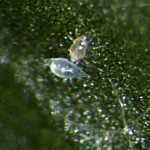Acarianul transparent (Tarsonemidae)
 The mite family Tarsonemidae is quite large and includes a variety of species. In general, this species of mites feeds on the mycelia of different species of fungi.
The mite family Tarsonemidae is quite large and includes a variety of species. In general, this species of mites feeds on the mycelia of different species of fungi.
Quite aggressive species were also discovered, for example the mites of the Acarapis species, dreaded pests of bees.
Representatives of the species, which feed on plants, seriously damages the cyclamen, strawberry, azaleas, the begonias, orchid, the lily, African violets, gloxinia etc.
On Gesneriaceae parasitizes two species of this family Phytonemus pallidus or mite cyclamaei (of the strawberry) and Polyphagotarsonemus latus or transparent greenhouse mite. In the English literature these creatures are called Broad Mite.
The transparent greenhouse mite can also be found in the specialized literature under the name of Hemitarsonemus latus and that of the cyclamate as Tarsonemus pallidus.
It is quite difficult to distinguish the species in question without a high-performance microscope. The mite of the cyclamate has claws on its legs, while the greenhouse mite they are completely missing. One has a length of up to 0.3 mm, the other one up to 0.2 mm. One mite has a slightly more elongated body shape than the other. Importantly, both mites damage the plant in a similar way and the methods of combating them are identical.
Tarsonemidae mites are tiny. Their detection is impossible without a microscope. Even with a microscope there is a possibility that these parasites are not observed on the affected plants. Because of this it is necessary to know where and how the specimens in question can be found.
If we are dealing with an apartment plant, the mites in question must be searched in the flower buds, in the folds of young leaves located near the point of apical growth, in the folds at the base of the leaf petioles. Here the humidity is high, and the high humidity is the main condition of prosperity of the pests in question.
The body of the females of the transparent greenhouse mite is round or elongated- round in the case of cyclarian, size 0.18-0.3 mm. It's glossy, yellowish translucent, yellow-vierzui or yellowish-brown in color.
Sometimes, on the body of the parasite, a longitudinal stripe is observed that widens in the front and back of the body of the mite. These are the digestive organs of the mite, filled with cellular juice. Both species have 4 pairs of legs each, in females the fourth pair of legs is thinner compared to the first three pairs.
Males are smaller than females. They have more massive limb extremities compared to those of females, and the third pair of legs is longer than the fourth.
Transparent greenhouse mite does not support air with a low level of humidity, in this environment the mites eggs would be compromised. To help the males jump, carrying the eggs, larvae and even females ,that are more massive than these, in a favorable environment, namely in the ajar buds of the plant.
The egg of the transparent greenhouse mite is whitish 0.1 mm long. On the surface of the egg are visible a series of convex points. The female of the transparent greenhouse mite lays only one egg at a time.
Instead, the female of the cyclamite lays eggs in a group of 2-3. They are translucent.
Larvae of the first stage of development have 3 pairs of legs. It actively moves on the surface of the plant and feeds on the cellular juice of the leaves. The larva in the second stage of development is immobile, does not feed and has the body covered with a double crust, because with the transition to the second stage of development, the larva of the transparent mite does not lose its first crust. At this stage of development, on the larva does not have the effect of any acaricide.
Plants invaded by the mites in question have a slow growth, new leaves are twisted and deformed, the flowers are very small and unsightly (have fine spots of white color). The flowers of the diseased plants deform and cease to open. With time the plant dies.
The transparent greenhouse mite develops much faster than the cyclanum. At high temperatures, in the first species a generation develops in 4-5 days, while the second species in 7-8 days.
This clue is important in establishing the chemical treatment schedule of the plant. In greenhouse conditions you can use Actelicul- two treatments at an interval of 5 days. In the apartments it is advisable to use fitoverm, ACTOFIT and ACARIN – 3-4 treatments at intervals of 3 days.
Sprinkle the growth points of the plant, the base of the rosette, the point of apical growth of the leaves, petioles of leaves. The flower buds will be removed from the contaminated plant.


polyphagotarsonemizii attack and plants from fam.solonaceae (prefers bell pepper and donut but also other subspecies) and can be effectively combated with Vertimec 0,08%-0,1% ,with Envidor 0,04%. ,Sanskrit , milbecknock etc.. As vegetable growers do not have a binocular or a high-performance microscope, they can use the symptoms of the attack reported here, often many of the growers can confuse the attack as a disease caused by other ag. Pathogens,,the site is f.educativ and helpful ptr. practitioners of flower vegetables, etc. Thanks to the filmmakers, ptr. their effort and I affirm that information and science mean POWER
Thanks for the added information!
Thank